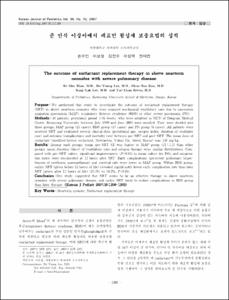준 만삭 이상아에서 폐표면 활성제 보충요법의 성적
- Keimyung Author(s)
- Kim, Chun Soo; Lee, Sang Lak; Kwon, Tae Chan
- Department
- Dept. of Pediatrics (소아청소년학)
- Journal Title
- Korean Journal of Pediatrics
- Issued Date
- 2007
- Volume
- 50
- Issue
- 12
- Abstract
- Purpose : We performed this study to investigate the outcome of surfactant replacement therapy (SRT) in above nearterm neonates who were required mechanical ventilatory care due to meconium aspiration pneumonia (MAP), respiratory distress syndrome (RDS) or other severe pneumonia (PN). Methods : 48 patients, gestational period ≥36 weeks, who were admitted in NICU of Dongsan Medical Center, Keimyung University between July 1999 and June 2004 were enrolled. They were divided into three groups, MAP group (15 cases), RDS group (27 cases) and PN group (6 cases). All patients were received SRT and evaluated several clinical data (gestational age, oxygen index, duration of ventilator
care) and outcome (complications and mortality rate) between pre-SRT and post-SRT. The mean dose of surfactant (modified bovine surfactant, Newfacten, Yuhan Co., Seoul, Korea) was 120 mg/kg. Results : Among each groups, mean pre-SRT OI was higher in MAP group (21±3.2) than other groups, mean duration (days) of ventilatory care and oxygen therapy were similar distributions. Compared with pre-SRT values, significant improvements (P<0.05) in mean values for FiO2 and oxygenation index were documented at 12 hours after SRT. Early complications (persistent pulmonary hypertension of newborm, pneumothorax) and survival rate were lower in MAP group. Within RDS group, earlier SRT (given before 12 hours of life) revealed significantly lower early complication rate than later SRT (given after 12 hours of life) (13.3% vs 58.3%, P<0.05)
Conclusion : Our study suggested that SRT seems to be an effective therapy in above nearterm neonates with severe pulmonary disease, and earlier SRT tends to reduce complications in RDS group than later therapy.
목 적 : SRT는 주로 RDS이 있는 미숙아에서 시행되어 왔다. 저자들은 폐질환을 주소로 인공 환기 요법이 필요했던 재태 주령 36주 이상의 신생아에서 폐표면 활성제를 이용한 보충요법의 투여 성적를 알아보고자 본 연구를 시행하였다. 방 법 : 1999년 7월부터 2004년 6월까지 계명대학교 동산의료
원 신생아 집중치료실에 입원한 후 폐질환을 주소로 인공 환기 요법을 받았던 재태 주령 36주 이상의 환아 중 SRT를 시행 받았던 48명의 환아를 대상으로 원인 질환에 따라 MAP군과 RDS군 그리고 PN군으로 나누어서 후향적으로 의무기록을 분석하였다. 모든 대상 환아들에서 SRT를 시행하였으며 폐표면 활성제(Newfacten: 유한양행, Seoul, Korea)는 120 mg을 생리식염수 2-4 mL에 용해하여 평균 120 mg/kg 용량으로 투여하였는데, RDS 군에서는 투여 6시간 후에도 임상적 호전이 미약할 때는 1회 더 투여하였다. 각 군에서 폐표면 활성제 사용 전 후의 임상지표(흡입 산소 농도 및 산소화 지수)와 폐표면 활성제 투여 시점으로부터의 총 인공 환기기 사용 및 산소 투여 기간을 알아보았으며 성적(합병증 및 생존율)를 분석하였다. 결 과 : 총 48례의 환아 중 MAP 군: 15명, RDS 군: 27명, PN 군: 6명 이었다. 폐표면 활성제 투여 전의 산소화 지수는 MAP 군이 21.8±3.2, RDS 군에서 18.3±4.5, PD 군에서 18.6±6.0였고, SRT 후 12시간째의 산소화 지수는 MAP 군이 8.61±6.75, RDS 군에서 4.98±0.69, PD 군에서 5.8±1.19로 통계적으로 유의하게 개선되었다(P<0.05). 총 인공 환기기 사용기간은 MAP 군이 4.9±1.2일, RDS 군이 5.5±2.8일, PN 군이 7.2±4.8일 이었고 산소 투여기간은 MAP 군이 9.4±1.7일, RDS 군이 8.8±3.5일, PN 군이 10.3±5.6일 이었다. 기흉, 신생아 폐 고혈압 지속증 등의 합병증 발생은 MAP 군에서 20%, RDS 군에서 25.9%, PD 군에서 50%로 나타났으며, 이중 RDS 군에서 SRT를 처음 시행한 시간에 따른 합병증의 발생 정도는 생후 12시간 전에 시행한 경우의 발생
률이 15례 중 2례(13.3%)로 12시간 이후에 시행한 경우의 12례 중7례(58.3%) 보다 유의하게 낮았다(P<0.05). 생존율은 MAP 군이 86.7%, RDS군과 PN 군이 모두 100%로 모든 군에서 양호한 예후를 보였다. 결 론 : 중증 폐 질환을 주소로 인공 환기 요법이 필요한 임신 기간 36주 이상의 준 만삭 이상아에서의 폐표면 활성제 보충요법은 좋은 임상경과를 가지며 특히 RDS인 경우 생후 12시간 내 투여가 합병증을 줄여서 치료성적의 향상에 도움이 될 것으로 사료된다.
- Alternative Title
- The outcome of surfactant replacement therapy in above nearterm neonates with severe pulmonary disease
- Publisher
- School of Medicine
- Citation
- 손수민 et al. (2007). 준 만삭 이상아에서 폐표면 활성제 보충요법의 성적. Korean Journal of Pediatrics, 50(12), 1200–1205. doi: 10.3345/kjp.2007.50.12.1200
- Type
- Article
- ISSN
- 1738-1061
- Appears in Collections:
- 1. School of Medicine (의과대학) > Dept. of Pediatrics (소아청소년학)
- 파일 목록
-
-
Download
 oak-aaa-03546.pdf
기타 데이터 / 198.51 kB / Adobe PDF
oak-aaa-03546.pdf
기타 데이터 / 198.51 kB / Adobe PDF
-
Items in Repository are protected by copyright, with all rights reserved, unless otherwise indicated.